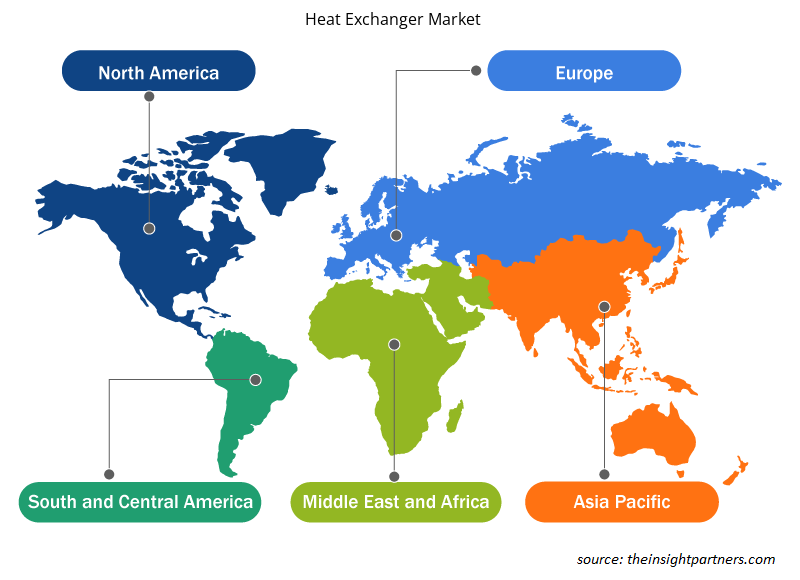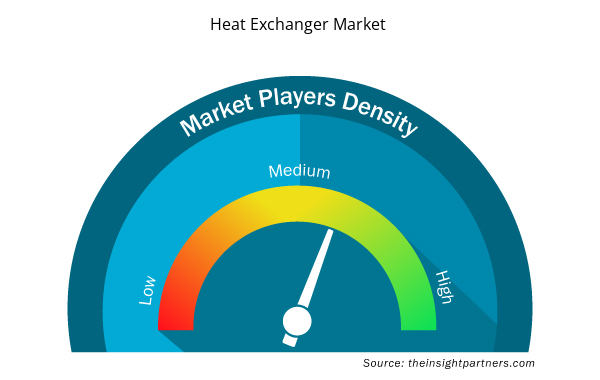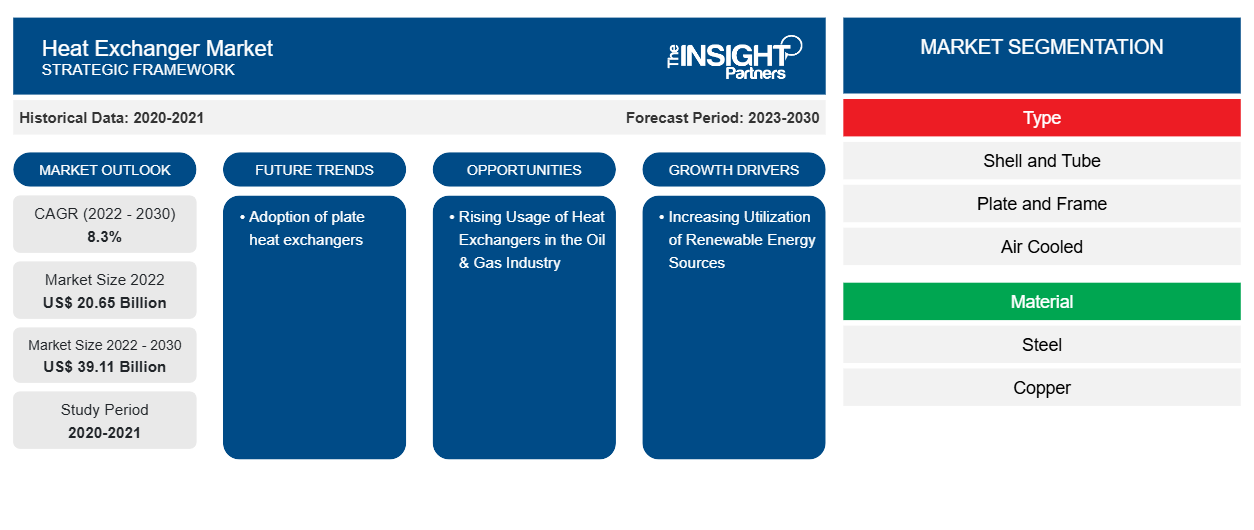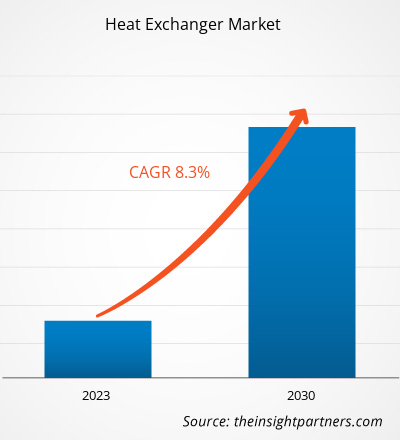熱交換器市場規模は、2022年の206億5,000万米ドルから2030年には391億1,000万米ドルに達すると予測されています。市場は2022年から2030年の間に8.3%のCAGRを記録すると予想されています。プレート式熱交換器の採用増加は、引き続き市場の主要なトレンドとなると思われます。
熱交換器市場分析
熱交換器は、顧客のニーズに応じて、一般的に加熱または冷却要素に使用されるデバイスであり、主にさまざまなプロセスおよび個別産業で採用されています。業界では、重要な機械や可燃性材料の過熱を防ぐために、冷却に熱交換器を使用しています。熱交換器の市場は世界的に成長しています。需要を牽引している主要な産業分野は、エネルギー、化学、食品、HVAC、海洋などです。世界中のすべての主要なプロセス産業では、さまざまな用途に熱交換器を使用しています。インダストリー 4.0、急速な工業化、石油およびガス産業の技術進歩はすべて、市場の成長を後押ししています。
熱交換器市場の概要
熱交換器市場で事業を展開するメーカーは、 石油化学および製油所の業務向けにさまざまな製品を発売しています。たとえば、2023 年 4 月には、モバイル モジュール式電力、温度制御、エネルギー ソリューションの世界的なプロバイダーである Aggreko が、大型ノード熱交換器とハステロイ C クロス フロー熱交換器という 2 つの新しいレンタル熱交換器ファミリーを発売しました。この既製のユニットは、石油化学および製油所の顧客に、業界最大の熱交換器であり、ハステロイで作られた唯一の熱交換器を提供します。どちらの製品も、石油化学プラントと製油所の円滑な運用を確保し、顧客の生産率を維持し、プラント プロセスを改善することで複雑な化学状況に対処できるように設計されています。
要件に合わせてレポートをカスタマイズする
このレポートの一部、国レベルの分析、Excelデータパックなど、あらゆるレポートを無料でカスタマイズできます。また、スタートアップや大学向けのお得なオファーや割引もご利用いただけます。
- このレポートの主要な市場動向を入手してください。この無料サンプルには、市場動向から見積もりや予測に至るまでのデータ分析が含まれます。
熱交換器市場の推進要因と機会
再生可能エネルギー源の利用拡大が市場を有利にする
風力や太陽光などのグリーン エネルギー オプションを発電に利用する傾向は高まっています。温室効果ガスの排出を削減する必要性により、世界中でエネルギー需要が増加しており、熱交換器の使用が求められています。これらのデバイスは風力タービン内にあり、システム内の流体の動きを促進して、ある程度の機械的な作業を可能にします。一方、太陽熱集熱器に取り付けて、表面から放射されるエネルギーの一部を吸収することもできます。
石油・ガス産業における熱交換器の使用増加
国際エネルギー機関(IEA)が2023年6月に発表した報告書によると、世界の石油需要は2022年から2028年にかけて6%増加すると予想されており、2028年には1日あたり最大1億570万バレルに達する見込みです。石油化学製品の需要増加と航空部門の石油需要増加により、需要は増加しています。さらに、石油とガスの探査、抽出、生産における上流部門への投資は、2015年以来の最高値に達すると予想されており、2023年には前年比11%増の5,280億米ドルに達すると予測されており、これは熱交換器市場に利益をもたらすでしょう。エコノミックタイムズによると、2023年1月、インドネシア国営エネルギー会社の製油所部門であるプルタミナは、古い製油所をアップグレードして新しい製油所を建設し、それによって処理能力を1日あたり150万バレル以上に増やすと発表しました。したがって、世界的な石油需要の増加と石油・ガス産業への投資は、生産中に発生する熱を除去するために熱交換器が使用される石油・ガスの生産に貢献しています。
熱交換器市場レポートのセグメンテーション分析
熱交換器市場分析の導出に貢献した主要なセグメントは、タイプ、材料、および用途です。
- タイプに基づいて、市場はシェルアンドチューブ、プレートアンドフレーム、空冷、その他に分類されます。シェルアンドチューブセグメントは、2022年に市場で最大のシェアを占めました。
- 材料に基づいて、熱交換器市場は鋼、銅、その他に分類されます。鋼セグメントは2022年に大きな市場シェアを占めました。
- 用途別に見ると、市場はエネルギー、化学、食品・飲料、HVACR、パルプ・紙などに分類されています。2022年にはエネルギー分野が最大の市場シェアを占めました。
地域別熱交換器市場シェア分析
熱交換器市場レポートの地理的範囲は、主に北米、アジア太平洋、ヨーロッパ、中東およびアフリカ、南米および中米の 5 つの地域に分かれています。
2022年には北米が市場を支配しました。北米の熱交換器市場は、米国、カナダ、メキシコに分割されています。米国は、2022年に北米の熱交換器市場で最大のシェアを占めました。この地域では、クリーンなエネルギー源の1つである水力発電を採用しており、増大するエネルギー需要を満たすために発電所を開発しています。たとえば、2021年1月の米国エネルギー省のレポートによると、水力発電容量は2017年以降、2019年に純増431MWとなっています。容量は、既存の施設、新しい施設、および非発電ダム(NPD)への電力供給から増加し、2010年から2019年までの合計純増は1,688MWとなりました。さらに、メキシコは、米国からの天然ガスの輸入を含め、天然ガス供給を増やすために多くのガス火力発電所を建設する計画を立てています。
熱交換器
熱交換器市場の地域別分析
予測期間を通じて熱交換器市場に影響を与える地域的な傾向と要因は、Insight Partners のアナリストによって徹底的に説明されています。このセクションでは、北米、ヨーロッパ、アジア太平洋、中東、アフリカ、南米、中米にわたる熱交換器市場のセグメントと地理についても説明します。

- 熱交換器市場の地域別データを入手
熱交換器市場レポートの範囲
| レポート属性 | 詳細 |
|---|---|
| 2022年の市場規模 | 206.5億米ドル |
| 2030年までの市場規模 | 391億1千万米ドル |
| 世界のCAGR(2022年 - 2030年) | 8.3% |
| 履歴データ | 2020-2021 |
| 予測期間 | 2023-2030 |
| 対象セグメント | タイプ別
|
| 対象地域と国 | 北米
|
| 市場リーダーと主要企業プロフィール |
|
熱交換器市場のプレーヤー密度:ビジネスダイナミクスへの影響を理解する
熱交換器市場は、消費者の嗜好の変化、技術の進歩、製品の利点に対する認識の高まりなどの要因により、エンドユーザーの需要が高まり、急速に成長しています。需要が高まるにつれて、企業は提供を拡大し、消費者のニーズを満たすために革新し、新たなトレンドを活用し、市場の成長をさらに促進しています。
市場プレーヤー密度とは、特定の市場または業界内で活動している企業または会社の分布を指します。これは、特定の市場スペースに、その市場規模または総市場価値に対してどれだけの競合相手 (市場プレーヤー) が存在するかを示します。
熱交換器市場で事業を展開している主要企業は次のとおりです。
- アルファ・ラバル
- ケルビオンホールディング GmbH
- ダンフォスAS
- ザイレム株式会社
- APIヒートトランスファー株式会社
- チャートインダストリーズ株式会社
免責事項:上記の企業は、特定の順序でランク付けされていません。

- 熱交換器市場のトップキープレーヤーの概要を入手
熱交換器市場のニュースと最近の動向
熱交換器市場は、主要な企業出版物、協会データ、データベースなどの一次調査と二次調査を経て定性的および定量的データを収集することで評価されます。以下に、熱交換器市場の動向をいくつか示します。
- L&T Heavy Engineering は、メキシコの製油所向けに、最も重い反応器とスクリュープラグ熱交換器の 1 つを受注しました。(出典: &T Heavy Engineering、プレスリリース、2023 年 1 月)
- ジョンソンコントロールズは、YORKソリューションの屋内および屋外の空調ユニットに、完全に統合された工場で製造されたラップアラウンド熱交換器(WAHX)を追加して設置し、コンパクトな設置面積でエネルギー効率の高い除湿方法に対する高まるニーズに応えたと発表しました。(出典:ジョンソンコントロールズ、プレスリリース、2022年2月)
熱交換器市場レポートの対象範囲と成果物
「熱交換器市場の規模と予測(2020〜2030年)」レポートでは、以下の分野をカバーする市場の詳細な分析を提供しています。
- 熱交換器市場の規模と予測、および対象範囲に含まれるすべての主要市場セグメントの世界、地域、国レベルでの予測
- 熱交換器市場の動向、推進要因、制約、主要な機会などの市場動向
- 詳細なPEST/ポーターの5つの力とSWOT分析
- 主要な市場動向、世界および地域の枠組み、主要プレーヤー、規制、最近の市場動向を網羅した熱交換器市場分析
- 市場集中、ヒートマップ分析、主要プレーヤー、超伝導市場の最近の動向を網羅した業界の状況と競争分析
- 詳細な企業プロフィール
- 過去2年間の分析、基準年、CAGRによる予測(7年間)
- PEST分析とSWOT分析
- 市場規模価値/数量 - 世界、地域、国
- 業界と競争環境
- Excel データセット


- Small Internal Combustion Engine Market
- Airport Runway FOD Detection Systems Market
- Smart Locks Market
- Precast Concrete Market
- Medical and Research Grade Collagen Market
- Cosmetic Bioactive Ingredients Market
- Bathroom Vanities Market
- Unit Heater Market
- Frozen Potato Market
- Intraoperative Neuromonitoring Market

Report Coverage
Revenue forecast, Company Analysis, Industry landscape, Growth factors, and Trends

Segment Covered
This text is related
to segments covered.

Regional Scope
North America, Europe, Asia Pacific, Middle East & Africa, South & Central America

Country Scope
This text is related
to country scope.
よくある質問
Alfa Laval AB, Kelvion Holding GmbH, Danfoss AS, Xylem Inc., and API Heat Transfer Inc. are among the leading players in the heat exchanger market.
The estimated value of the heat exchanger market is expected to reach US$ 39.11 billion by 2030.
The market is expected to grow at a CAGR of 8.3% over the forecast period.
North America dominated the heat exchanger market in 2022.
All major process industries across the globe use heat exchangers for several applications. Industry 4.0, rapid industrialization, and technological advancements in the oil & gas industries are all boosting the growth of the market.
The increasing adoption of plate heat exchangers is likely to remain a key trend in the market.
Trends and growth analysis reports related to Electronics and Semiconductor : READ MORE..
The List of Companies - Heat Exchanger Market
- Alfa Laval AB
- Kelvion Holding GmbH
- Danfoss AS
- Xylem Inc
- API Heat Transfer Inc
- Chart Industries Inc
- Guntner GmbH & Co KG
- Larsen & Toubro Ltd
- Hisaka Works Ltd
- Johnson Controls International Plc
The Insight Partners performs research in 4 major stages: Data Collection & Secondary Research, Primary Research, Data Analysis and Data Triangulation & Final Review.
- Data Collection and Secondary Research:
As a market research and consulting firm operating from a decade, we have published and advised several client across the globe. First step for any study will start with an assessment of currently available data and insights from existing reports. Further, historical and current market information is collected from Investor Presentations, Annual Reports, SEC Filings, etc., and other information related to company’s performance and market positioning are gathered from Paid Databases (Factiva, Hoovers, and Reuters) and various other publications available in public domain.
Several associations trade associates, technical forums, institutes, societies and organization are accessed to gain technical as well as market related insights through their publications such as research papers, blogs and press releases related to the studies are referred to get cues about the market. Further, white papers, journals, magazines, and other news articles published in last 3 years are scrutinized and analyzed to understand the current market trends.
- Primary Research:
The primarily interview analysis comprise of data obtained from industry participants interview and answers to survey questions gathered by in-house primary team.
For primary research, interviews are conducted with industry experts/CEOs/Marketing Managers/VPs/Subject Matter Experts from both demand and supply side to get a 360-degree view of the market. The primary team conducts several interviews based on the complexity of the markets to understand the various market trends and dynamics which makes research more credible and precise.
A typical research interview fulfils the following functions:
- Provides first-hand information on the market size, market trends, growth trends, competitive landscape, and outlook
- Validates and strengthens in-house secondary research findings
- Develops the analysis team’s expertise and market understanding
Primary research involves email interactions and telephone interviews for each market, category, segment, and sub-segment across geographies. The participants who typically take part in such a process include, but are not limited to:
- Industry participants: VPs, business development managers, market intelligence managers and national sales managers
- Outside experts: Valuation experts, research analysts and key opinion leaders specializing in the electronics and semiconductor industry.
Below is the breakup of our primary respondents by company, designation, and region:

Once we receive the confirmation from primary research sources or primary respondents, we finalize the base year market estimation and forecast the data as per the macroeconomic and microeconomic factors assessed during data collection.
- Data Analysis:
Once data is validated through both secondary as well as primary respondents, we finalize the market estimations by hypothesis formulation and factor analysis at regional and country level.
- Macro-Economic Factor Analysis:
We analyse macroeconomic indicators such the gross domestic product (GDP), increase in the demand for goods and services across industries, technological advancement, regional economic growth, governmental policies, the influence of COVID-19, PEST analysis, and other aspects. This analysis aids in setting benchmarks for various nations/regions and approximating market splits. Additionally, the general trend of the aforementioned components aid in determining the market's development possibilities.
- Country Level Data:
Various factors that are especially aligned to the country are taken into account to determine the market size for a certain area and country, including the presence of vendors, such as headquarters and offices, the country's GDP, demand patterns, and industry growth. To comprehend the market dynamics for the nation, a number of growth variables, inhibitors, application areas, and current market trends are researched. The aforementioned elements aid in determining the country's overall market's growth potential.
- Company Profile:
The “Table of Contents” is formulated by listing and analyzing more than 25 - 30 companies operating in the market ecosystem across geographies. However, we profile only 10 companies as a standard practice in our syndicate reports. These 10 companies comprise leading, emerging, and regional players. Nonetheless, our analysis is not restricted to the 10 listed companies, we also analyze other companies present in the market to develop a holistic view and understand the prevailing trends. The “Company Profiles” section in the report covers key facts, business description, products & services, financial information, SWOT analysis, and key developments. The financial information presented is extracted from the annual reports and official documents of the publicly listed companies. Upon collecting the information for the sections of respective companies, we verify them via various primary sources and then compile the data in respective company profiles. The company level information helps us in deriving the base number as well as in forecasting the market size.
- Developing Base Number:
Aggregation of sales statistics (2020-2022) and macro-economic factor, and other secondary and primary research insights are utilized to arrive at base number and related market shares for 2022. The data gaps are identified in this step and relevant market data is analyzed, collected from paid primary interviews or databases. On finalizing the base year market size, forecasts are developed on the basis of macro-economic, industry and market growth factors and company level analysis.
- Data Triangulation and Final Review:
The market findings and base year market size calculations are validated from supply as well as demand side. Demand side validations are based on macro-economic factor analysis and benchmarks for respective regions and countries. In case of supply side validations, revenues of major companies are estimated (in case not available) based on industry benchmark, approximate number of employees, product portfolio, and primary interviews revenues are gathered. Further revenue from target product/service segment is assessed to avoid overshooting of market statistics. In case of heavy deviations between supply and demand side values, all thes steps are repeated to achieve synchronization.
We follow an iterative model, wherein we share our research findings with Subject Matter Experts (SME’s) and Key Opinion Leaders (KOLs) until consensus view of the market is not formulated – this model negates any drastic deviation in the opinions of experts. Only validated and universally acceptable research findings are quoted in our reports.
We have important check points that we use to validate our research findings – which we call – data triangulation, where we validate the information, we generate from secondary sources with primary interviews and then we re-validate with our internal data bases and Subject matter experts. This comprehensive model enables us to deliver high quality, reliable data in shortest possible time.


 このレポートの無料サンプルを入手する
このレポートの無料サンプルを入手する